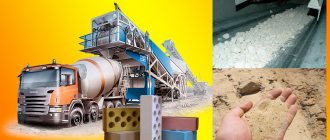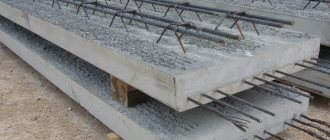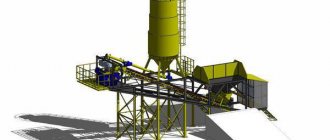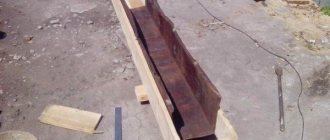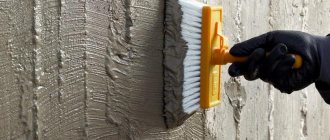Reinforced concrete cable trays are used in the process of constructing thermal routes, laying utility networks, installing hydraulic facilities, sewer lines, tunnels, etc. The trays are a U-shaped concrete profile structure, inside which lines, wires, and other elements are laid, and then covered with lids. In this way, it is possible to protect the elements from the influence of external negative factors and prevent unauthorized people from gaining access to them.
The reinforced concrete cable tray demonstrates increased reliability and structural strength. Manufactured in accordance with the requirements of norms and standards. Provides complete safety to the structures and highways that are located in it, simplifies and speeds up the installation process.
Why do precast concrete companies produce trays?
The production of reinforced concrete cable trays is carried out in specialized enterprises and factories, in accordance with GOST standards and design documentation. The products are characterized by high strength, and therefore the scope of their use is very wide.
Where are reinforced concrete trays used:
- Utilities industry
- Industrial and residential construction
- Road construction sector
- Energy sector
As for the implementation of specific tasks, trays are used in the construction of industrial and commercial facilities, parking complexes, residential buildings, in the process of arranging terraces, laying roads, and installing wiring.
Relevant when sewer line structures are being created, electrical cables of substations with transformers, telecommunication lines are being laid, open and closed drainage systems are being built, closed drainage channels, water supply lines and drainage channel systems, and pipe laying.
Reinforced concrete tray is a universal building structure that is used in a wide variety of fields and jobs. It can be equipped with a lid, requires laboratory control of the raw materials used and a thorough check of the quality of the finished product.
Concrete tray: main types of tray products
Cable trays can be different and differ in certain characteristics. The specific type is selected in accordance with the assigned tasks, operating conditions, and installation features of communication elements.
Trays are divided according to the following characteristics:
- dimensions
- Design
- Availability and possibility of completing with a lid
- Installation features
- Functional purpose
The most popular types of tray channels in modern construction:
1) Structures with a U-shaped cross-section, made in the shape of a rectangular parallelepiped. They are chosen for the construction of composite canals, arrangement of drainage, and water drainage. The increased dimensions of the channels make it possible to lay different types of electrical cables on stands. The strength of the channels is ensured by the resistance of the products to various factors and loads. Reinforced concrete cable trays of this type are suitable for installation in freezing and wet soils.
2) Trapezoidal - make it possible to make telescopic connections, which is ensured by changing the width of the product along its longitudinal axis. Thanks to the fixed dimensions of the elements, it is possible to guarantee high accuracy of channel pairing and significantly speed up the installation process.
Such products are often installed on the sides of highways to drain water from the road surface. They are not afraid of external factors and do not absorb moisture.
3) Culverts - used for effective drainage, mounted along road surfaces. Installed on a slope to allow water to drain. Production is carried out using the method of prestressing reinforcement and drying at high temperatures to significantly improve mechanical parameters.
If we consider the marking of reinforced concrete cable trays, it gives information about their purpose: the MZhBL product is used for the construction of drainage and drainage channels, UBK stands for energy trays, L for the design of heating mains and road structures, MSHL for railway lines.
The tightness of the tray is ensured by a lid or road slabs, which are installed to close the internal cavity. In such a box that reliably protects them from damage, cables, pipes, and elements of various types of equipment can work for a long time and correctly.
Reinforced concrete trays
Reinforced concrete trays are high-strength products designed primarily to protect and isolate laid pipelines, cables and other communication systems from various environmental influences and premature destruction.
Reinforced concrete trays are one of the most popular reinforced concrete products. A simple, but ergonomic and universal design allows them to be effectively used in many areas of construction - road and engineering construction, construction of bridges, tunnels and overpasses, for laying pipelines for various purposes. Reinforced concrete trays serve as a drainage and passage of hot and cold water, and are used for laying heating pipelines and various electrical cables.
Reinforced concrete trays are used both in open spaces, including roads, terraces, playgrounds, courtyards, stadiums, park areas, power lines and gas stations, and indoors, where there is a need to drain atmospheric precipitation or industrial water.
The widespread use of reinforced concrete trays is also explained by the low cost of raw materials, simple manufacturing method, ease of installation and ease of maintenance. Let's add to this the high strength of steel-reinforced concrete, which allows the products to withstand significant loads throughout their entire service life. Reinforced concrete products are famous for their durability, without losing their original characteristics. Thus, the use of reinforced concrete trays can significantly reduce costs during the construction of roads, multi-storey buildings and other real estate objects.
Depending on their application, reinforced concrete trays can be divided into several types:
- Trays for heating mains and heating main coverings;
- Cable trays and LC trays;
- Drainage trays;
- Drainage trays;
- Irrigation system trays.
Trays for covering heating mains are used to ensure heat supply between the heat source and its consumer when laying heat supply systems in non-through, semi-through, and through channels. The heat source is pipes that are located in the tray. With the help of trays, an air cushion is created between the pipe and the gutter, which retains heat, acting as a reliable heat insulator. The necessary tightness and water resistance are achieved by adding special mixtures and impurities.
Cable trays are used for the installation of electrical cables in the thickness of the earth's rocks and their subsequent uninterrupted operation. These trays require the presence of embedded parts that are attached to the internal walls of the products. Embedded parts are used to firmly secure electrical cables and cable structures. The use of reinforced concrete trays allows you to reliably protect electrical cables from moisture, which leads to corrosion of elements and, ultimately, failure of the power supply system.
Drainage trays are used to intercept and drain rain and storm water from residential areas, roads, etc. to prevent water stagnation in the area. High-strength reinforced concrete trays are able to withstand aggressive environments caused by climatic conditions and constant, high levels of humidity. For example, in urban construction, drainage trays with a high degree of reliability protect the foundations of houses from excess moisture, significantly extending the life of buildings. Special drainage trays are widely used in both automobile and railway construction.
Irrigation channel trays are used in irrigation systems during the construction of hydraulic structures in engineering construction. With the help of trays, the water regime in various territories is changed and regulated. Irrigation channel trays perform both the functions of collection, intake, and conduction and drainage of water, ensuring the uninterrupted operation of irrigation systems and their mechanisms, which are constantly located in an environment with a high level of humidity.
Reinforced concrete trays are elongated brackets with a U-shaped or parabolic cross-section. This form is determined by the function of the tray - the pipeline or other communication systems inside the tray are reliably protected, liquids cannot leave their channel. The upper, open part of the trays is covered with a channel covering slab. Such a solution is necessary so that during regular maintenance and repair of facilities it is possible to quickly and easily reach the required sections of pipes and cables. Ease of maintenance is the main advantage of using reinforced concrete trays as protective structures.
Reinforced concrete trays are manufactured in accordance with the requirements of series 3.006.1-2.87 “Prefabricated reinforced concrete channels and tunnels from tray elements”, 3.006.1-8 “Prefabricated reinforced concrete channels and tunnels from tray elements”, as well as 3.501-68 “Precast reinforced concrete intersleeper trays on the railway tracks of industrial enterprises." Irrigation channel trays are manufactured in accordance with GOST 21509-76 “Reinforced concrete trays for irrigation systems. Technical specifications”, cable trays - according to series 3.407.1-157 “Unified reinforced concrete products for 35-500 kV substations”. The practicality of the design of reinforced concrete trays lies in the fact that they are multifunctional, therefore, often, for example, trays intended for installing cables are used as drainage and vice versa, etc. Drainage trays used in drainage structures on highways are manufactured in accordance with series 3.503.1-66 “Prefabricated reinforced concrete products for drainage structures on highways. Working drawings".
In the production of trays, only heavy concrete of high compressive strength classes B15, B25, B30 and B35 is used. Concrete classes for frost resistance and water resistance are assigned depending on the hydrogeological conditions of the construction site, the presence and type of external and internal waterproofing of the trays.
The reinforcement of reinforced concrete trays is produced by welded mesh and frames made of steel of classes A-I A-III in accordance with GOST 6781-82 and class BpI in accordance with GOST 6727-80. For the manufacture of embedded products, rolled steel Vst3kp2 is used in accordance with GOST 380-71, anchors for embedded products are made of class A-III steel in accordance with GOST 5781-82. The mounting loops are made of class A-I steel grades Vst3sp2 and Vst3ps2. In case of installation of structures at a design winter temperature below -40°C, the use of steel grade Vst3ps2 is not allowed.
The marking of reinforced concrete trays according to series 3.006.1-2.87 consists of letters and numbers, where L is a reinforced concrete tray. The number after the letter indicates the serial number of the product, the number after the dash indicates the value of the vertical uniformly distributed equivalent design load. The brand of the tray with embedded products contains an additional letter “a”. The letter “d” is added to the brand of additional trays.
The brand of reinforced concrete trays according to series 3.006.1-8 has an alphanumeric designation, where: LK - tray, LKO - tray with a hole. The number after the letters indicates the nominal size of the tray along the channel in cm. The number after the dot is the nominal size of the tray along the channel width in cm. The next number after the dot is the nominal height of the tray in cm. Then, separated by a hyphen, a digital index is indicated that characterizes the type of reinforcement element. After the digital index, an additional letter index “a” may be indicated, characterizing the distinctive features of the element: the presence of embedded products (except for sling loops).
The marking of cable trays in accordance with the 3.407.1-157 series consists of groups. The first group of alphanumeric designation includes the letter of the product's conventional name, L - tray, and the main overall dimensions in dm. The second group, a hyphenated number, indicates the load-bearing capacity in kN/m. The third group, a number also separated by a hyphen, indicates design features (reinforcement option, presence of additional embedded parts).
The marking of trays for irrigation systems in accordance with GOST 21509-76 consists of one alphanumeric group and contains the designation of the type of tray and the nominal height of the tray in decimeters, the value of which is rounded to the nearest whole number, where: LR - trays built on piles, rack supports and slabs; LRG - trays laid in the ground.
According to series 3.503.1-66, reinforced concrete drainage trays are marked with a letter designation, where: L - tray, B - telescopic drainage tray block. Next, separated by a hyphen, there is a number indicating the serial number of the product.
Trays of the B3.300.1-5.04 series are marked with the letters LB, followed by a number indicating the serial number of the product.
Trays of the 3.900.1-12 series are marked with alphanumeric indices, which indicate: the alphabetic index at the beginning of the mark - L - tray; the first digit of the letter index is the number of the standard size of the element - an analogue of the series 3.006.1-2.87; number 0 – additional standard size; the letter “a” is a shortened tray 3 m long; the number after the dash is the type of tray according to the conditions of support: 1 – on a solid base, 2 – on supports; the letter “K” at the end of the mark is intended for sewage systems;
Brands of prefabricated trays series 3.903 KL-14 consist of alphabetic and digital indices. The letter index characterizes the type of tray (LT – heating tray, ULT – corner heating tray). The numbers after the letters determine the geometric dimensions of the tray in decimeters (length, width, height), rounded to whole numbers.
Reinforced concrete trays of pass-through and non-pass-through channels of album SK 3301-86 are marked according to an alphanumeric system. The letters indicate: LP - tray floor, LPO - tray floor with a hole, LD - tray bottom, LDO - tray bottom with a hole for a pit, LDP - tray bottom with support pads, LU, LPU, LDU - tray corner element for mating trays when the channel is rotated at an angle of 90°, LO is a lightweight tray element. The numbers show the largest diameter of the pipe laid in the channel, in decimeters. The index “i” distinguishes the elements of the ribbed structure of the channels, “u” distinguishes the reinforced elements of the ribbed design of the channels.
Reinforced concrete cable trays: product advantages
Before it began producing reinforced concrete cable trays, communication lines and pipelines were installed in channels built of brick. But the characteristics of such structures were not very good, since they were not durable and reliable, had a short service life and were not suitable for repair.
The main advantages of reinforced concrete cable trays:
- Strength and reliability, resistance to loads and aggressive environments, integrity during ground movement (which is why they can be used in seismically active zones, wet soils), frost resistance. The trays are not afraid of sudden changes in moisture temperature, since the air cushion acts as a natural thermal insulation layer.
- Maintainability - by removing the top layer of soil and lifting the protective cover, you can quickly and easily carry out the necessary measures, repair or replace elements, and then apply coating mastic, cover with a lid, cover with soil and continue to operate communications.
- Speed of construction of communication channels.
- Tightness - after the installation is completed and the joints are cemented, the cover is installed, the lines are reliably protected from precipitation and groundwater.
- Reduced overall installation costs compared to brick structures.
- Long service life - trays in which cables, pipes, and other elements are laid can last several decades, or even more.
Concrete trays
Reinforced concrete drainage trays are building materials made from heavy concrete based on a frame made of steel reinforcement. These products are produced in accordance with GOST 23009-78, based on Portland cement grade no lower than M400 and steel reinforcement of class A-1, A-3; gravel, granite, and selected sand are used as fillers. Such reinforced concrete trays are used in all structures and all types of soil, except those that are aggressive to concrete. In cases where the environment is aggressive, sulfate-resistant Portland cement is used in the manufacture of such specialized products.
Reinforced concrete trays of grade L are used for laying channels for various purposes. Usually these are heating mains, cold water pipes or drainage pipes. Less commonly used for laying cables.
Channel trays of the LK brand, series 3.006.1-8, along with reinforced concrete trays of the L brand, for example trays L1 and L2, are used for laying channels for various purposes. Compared to the construction of brick channels, the use of ready-made elements has a number of advantages - simpler and faster installation, as well as easy replacement of a broken segment. Channel trays of the LK brand are used for laying channels for various purposes. Compared to the construction of brick channels, the use of ready-made elements has a number of advantages - simpler and faster installation, as well as easy replacement of a broken segment.
Application options for reinforced concrete trays
Trays for covering heating mains are used to ensure heat supply between the heat source and its consumer when laying heat supply systems in non-through, semi-through, and through channels. The heat source is pipes that are located in the tray. With the help of trays, an air cushion is created between the pipe and the gutter, which retains heat, acting as a reliable heat insulator. The necessary tightness and water resistance are achieved by adding special mixtures and impurities.
Cable trays are used for the installation of electrical cables in the thickness of the earth's rocks and their subsequent uninterrupted operation. These trays require the presence of embedded parts that are attached to the internal walls of the products. Embedded parts are used to firmly secure electrical cables and cable structures. The use of reinforced concrete trays allows you to reliably protect electrical cables from moisture, which leads to corrosion of elements and, ultimately, failure of the power supply system.
Drainage trays are used to intercept and drain rain and storm water from residential areas, roads, etc. to prevent water stagnation in the area. High-strength reinforced concrete trays are able to withstand aggressive environments caused by climatic conditions and constant, high levels of humidity. For example, in urban construction, drainage trays with a high degree of reliability protect the foundations of houses from excess moisture, significantly extending the life of buildings. Special drainage trays are widely used in both automobile and railway construction.
Irrigation channel trays are used in irrigation systems during the construction of hydraulic structures in engineering construction. With the help of trays, the water regime in various territories is changed and regulated. Irrigation channel trays perform both the functions of collection, intake, and conduction and drainage of water, ensuring the uninterrupted operation of irrigation systems and their mechanisms, which are constantly located in an environment with a high level of humidity.
The main advantages of reinforced concrete trays
The following advantages can be identified due to the use of railway trays:
— a channel made of trays increases the load-bearing capacity;
- relatively low cost;
— can be used in areas of seismic activity, floating soil;
— installation is carried out quickly.
Purchase and delivery of reinforced concrete trays
We offer to buy reinforced concrete trays L, trays L1, L-2, and LK with delivery throughout Moscow and the Moscow region by road, as well as buy concrete trays L with delivery throughout Russia by rail at the best prices.
Reinforced concrete tray: design features and sizes
Reinforced concrete cable trays are made of concrete grades B20-B25, which is prepared from a concrete mixture of crushed stone, sand and cement grades M400, M500. The solution is characterized by increased resistance to moisture due to the fact that special modifying components are introduced into it. The structure is strengthened with reinforcing bars of class A1 and higher. The grid is mounted from individual steel rods connected with annealed knitting wire.
All products are universal. Thanks to the special formulation, cable trays can be used in a wide variety of conditions, soils, climates, and areas with any seismic activity. The geometric dimensions are met exactly, as are the specifications.
Depending on the design, reinforced concrete cable trays can have different dimensions: length in the range of 740-3950 centimeters, width from 280 to 2380 centimeters, height in the range of 28-118 centimeters. The weight of small reinforced concrete trays can be equal to 100 kilograms, products with maximum dimensions weigh up to 2.7 tons. Weight in kg must be indicated by the manufacturer.
How concrete cable trays are made
The production process requires strict adherence to standards and norms. Due to the increased strength characteristics and requirements for resistance to various environments and operating conditions, the slightest deviation from the standard can make the cable tray unsuitable for work. Therefore, it is best to purchase products from proven factories and production facilities.
Main stages of production of reinforced concrete cable trays:
- Cutting blanks from steel rods to create a reinforcement frame.
- Assembling the frame using knitting wire and electric welding.
- Treatment of the surface of the rods with anti-corrosion compounds.
- Coating the inner surface of a metal casting mold for pouring concrete in order to simplify the process of removing the finished tray.
- Installing the frame in the mold, ensuring its immobility.
- Preparation of concrete mortar according to recipe in a bunker.
- Filling the form with concrete mixture, ensuring its complete immobility.
- Dismantling of metal formwork and removal of the finished product, thorough quality control in the laboratory: visual inspection, rejection of trays with defects, checking geometric dimensions and rejection of trays whose dimensions do not meet the standard, checking operational characteristics.
Finished reinforced concrete cable trays are marked with paint on the end with letters and numbers.
Application specifics
Reinforced concrete cable trays are used in several versions. They can be used for ground installation - they are mounted on a previously prepared surface, and after completion of work they are closed with lids. In this case, easy access to the tray is provided, installation work is cheaper and completed faster.
If a recessed installation option is performed, then they are placed in a dug trench on a surface prepared in advance. After installing the wiring, pipes or other elements inside the tray, close it with a lid and pour soil on top. Access to such highways is excluded, but if necessary, repairs are still easier to carry out than in the case of communications simply buried in the ground. And the protection is much higher.
In the construction industry, both options are used, choosing the most suitable one for a particular job. During installation, entire products are used, since thanks to the wide range and large number of additional elements, a structure of any configuration can be assembled. For the construction of heating mains, LK 75 is most often used, for electrical networks, LK 300.
Cable channels
Design and dimensions
Gutters for wiring installation are made in the form of open U-shaped containers.
For their manufacture we use:
- Concrete grades B15, B20 or B25.
- Steel reinforcement class A1 or A2.
These products are able to withstand significant temperature changes due to the fact that during their manufacture components are added to the solution that prevent cracking.
The tray itself and the lid
As a rule, when installing communication channels, entire products are used; fortunately, most manufacturers have a significant number of additional elements in their assortment.
The sizes of reinforced concrete cable trays that are most often used are given in the table below:
| Name | Weight, kg | Length, mm | Width, mm | Height, mm |
| LK3 | 270 | 1990 | 1100 | 150 |
| LK4 | 220 | 1990 | 850 | 150 |
| LK5 | 170 | 1990 | 600 | 150 |
| UBK1A | 275 | 1990 | 1000 | 160 |
| UBK2A | 175 | 1990 | 500 | 160 |
| L 20-5 | 125 | 1990 | 500 | 160 |
| L 20-10 | 275 | 1990 | 1000 | 160 |
However, in some situations it becomes necessary to adjust the product to a specific size. In this case, cutting reinforced concrete with diamond wheels is used, since the gutter material is highly durable, and attempts to process it with other tools lead to rapid wear.
Features of use
Model with polymer cover
As the name suggests, the instructions recommend using such products for above-ground installation of communication wires.
This provides the following benefits:
- The cables are housed in a housing that reliably protects them from damage due to both mechanical stress and the influence of weather factors.
Note! The design of the case does not provide for the presence of locking elements, so the risk of theft remains. It is for this reason that the external installation of gutters is justified only within protected areas.
- If you need access to the conductors, simply open the trench. Of course, the slabs themselves are quite heavy, but it will still be much less expensive than in the case of placing wires in a trench covered with earth.
- Finally, in areas with difficult soils (permafrost, quicksand, stone monolith) this is the only option for placing cables.
Burying into the ground
However, in some cases, such structures are buried in the ground.
At the same time, we receive the following advantages:
- Firstly, all communications are located in a relatively dry space without contact with soil moisture. This allows you to save money by using cables with a lower moisture protection class.
- Secondly, the connection of several cable routes is facilitated. To insert additional wire into the tray, diamond drilling of holes in concrete is used.
Note! The drilled holes through which the wire is passed should be carefully sealed.
- Finally, with proper organization of the internal space (separating wires by voltage and purpose using partitions and wall mounting systems), sorting is greatly simplified. Agree, it is much easier to remove the cover from a concrete tray and look for the required cable than to dig a hole, risking cutting the conductor with a shovel or excavator bucket.
Schemes for placing conductors in the trench cavity
In principle, both installation options are acceptable and are actively used in modern construction.


